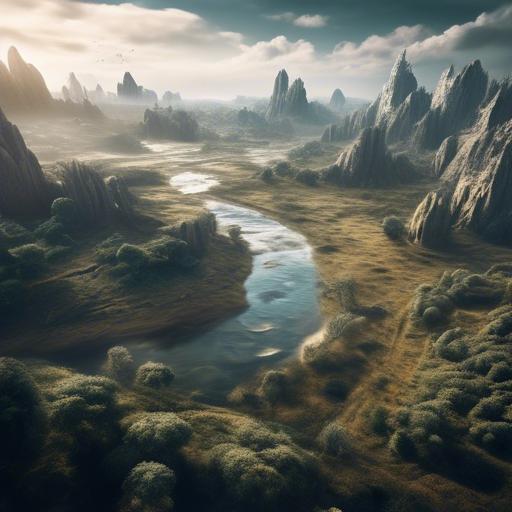Ever dreamed of painting the world in your mind’s eye, transforming blank canvases into breathtaking vistas of rolling hills, serene lakes, and sunlit forests? Well, welcome to the future, where the brush in your hand might just be a line of code, and artificial intelligence acts as your creative companion. In this article, we will embark on a journey to uncover the secrets behind creating realistic landscapes with AI, a realm where imagination converges with cutting-edge technology. Whether you’re an aspiring digital artist or a seasoned pro looking to add a futuristic twist to your portfolio, we’re here to guide you, step-by-step, through this innovative fusion of art and algorithms. Get ready to watch your creative landscapes come to life like never before, powered by the remarkable synergy of human creativity and artificial intelligence.
Table of Contents
- Choosing the Right AI Tools for Landscape Creation
- Mastering Color Palettes and Lighting Effects
- Enhancing Textures and Details with Advanced Techniques
- Integrating Natural Elements Seamlessly
- Optimizing Performance for Large-Scale Projects
- Incorporating User Feedback for Realism
- Staying Updated with AI Innovations in Landscape Design
- Balancing Creativity and Automation in Your Workflow
- Building an Impressive AI-Generated Portfolio
- Closing Remarks
Choosing the Right AI Tools for Landscape Creation
When diving into the world of AI for landscape creation, it’s essential to select tools that not only suit your creative needs but also align with your technical expertise. **AI-powered tools** can significantly streamline your process by providing vast libraries of assets, advanced rendering capabilities, and intuitive interfaces. Here’s a rundown of some crucial factors to consider when choosing your AI allies for landscape creation:
- User Interface: Ensure the platform is user-friendly with a clean interface. This makes navigating the software seamless, allowing you to focus on creativity rather than technical complexities.
- Asset Library: A rich library of pre-designed elements such as trees, mountains, water bodies, and sky elements can ignite your creativity and save time.
- Customization Options: Flexibility to customize elements and integrate personal assets will provide a unique touch to your landscapes.
- Rendering Quality: Look for tools that offer high-definition rendering. The finer the details, the more realistic your landscape will appear.
Evaluating the features of different AI tools can be time-consuming, so here’s a comparison table of popular choices to help you make an informed decision:
| Tool | Best For | Notable Features |
|---|---|---|
| **Lumion** | **Architectural Visualizations** | Real-time Rendering, Extensive Asset Library |
| **Autodesk Maya** | **Professional Animation** | Advanced Dynamics and Effects, High Customization |
| **Terragen** | **Photorealistic Landscapes** | Sky and Lighting Simulations, Terrain Modeling |
Another important aspect to consider is **community support and resources**. Opt for tools that have a thriving user community, rich documentation, and active forums. This support can be invaluable when troubleshooting or looking for inspiration. Many communities often share tutorials, tips, and asset libraries, which can further enhance your learning and creation process.
**budget constraints** can play a significant role in your decision. While premium tools offer a plethora of features, many free or affordable alternatives still provide excellent capabilities for budding creators. Balancing the cost against the features and your specific needs will ensure you invest wisely in your landscape creation journey.
Mastering Color Palettes and Lighting Effects
Achieving a compelling landscape requires a mastery of color palettes and lighting effects. The combination of hues and light techniques can transform an ordinary scene into an extraordinary work of art. Here are some key strategies to consider:
- Choose a Dominant Color Palette: Establish a clear theme with dominant colors. Desert scenes benefit from warm hues like sandy yellows and deep oranges, while forest landscapes thrive with a mix of lush greens and earthy browns.
- Incorporate Lighting Gradients: Gradients can add depth to your landscape. Simulate the subtle shift in lighting from dawn to dusk, creating a sense of time and movement in your scenery.
Pairing your chosen color palette with the right lighting can make or break the realism of your AI-generated landscape. Consider the following lighting effects to enhance your scene:
| Lighting Effect | Best Use |
|---|---|
| Soft Shadows | Creating a tranquil and peaceful atmosphere |
| Contrasting Highlights | Emphasizing dramatic and dynamic features |
| Directional Light | Simulating sunlight or moonlight |
**Light and Shadow Interaction:** Realistic landscapes often hinge on the interplay between light and shadow. Use shadows to provide context, indicating the shape and distance of objects. Shadows should not be too harsh unless capturing a high-contrast environment such as a midday desert.
Experimentation is key. Don’t be afraid to tweak your settings and explore unconventional color combinations. AI tools often allow rapid iteration, so take advantage of this to perfect your color palettes and lighting effects. By integrating these elements thoughtfully, your landscapes will captivate any viewer, transporting them to the very scene you’ve created.
Enhancing Textures and Details with Advanced Techniques
One of the most transformative aspects of creating realistic landscapes with AI is the ability to enhance textures and details beyond what traditional methods allow. Leveraging advanced techniques not only elevates the aesthetic quality but also ensures a level of immersion that captivates viewers.
Start by employing high-resolution texture maps. These maps help to add a lifelike element to surfaces, whether it’s the ruggedness of a mountain cliff or the subtle intricacies of tree barks. Using **displacement mapping** can significantly increase the realism by adding physical depth to flat images. You can layer these with **normal maps** to further enrich the texture, providing more interaction with light and shadow in your scene.
Another crucial technique is **procedural texturing**. This method allows you to generate textures algorithmically, ensuring a non-repetitive and more natural look. Procedural texturing can adapt to changes in the landscape dynamically, creating variations in the terrain that look organically evolved rather than artificially placed. This approach works particularly well for sprawling landscapes where manual texturing would be impractical.
Here’s a quick comparison of key techniques:
| Technique | Advantage |
|---|---|
| Displacement Mapping | Adds physical depth to textures |
| Normal Mapping | Enhances light and shadow interaction |
| Procedural Texturing | Generates non-repetitive textures |
To further push the boundaries, incorporate **detail maps**. These are additional texture maps that add a finer layer of detail to specific areas. For instance:
- Use detail maps for close-up textures like pebbles on a riverbed.
- Implement them on foliage to exhibit the delicate structure of leaves.
- Apply them to water surfaces to illustrate subtle ripples and reflections.
By masterfully blending these advanced techniques, you unlock a palette of possibilities that brings AI-generated landscapes to life with stunning detail. Your landscapes will not just be viewed; they will be experienced.
Integrating Natural Elements Seamlessly
Incorporating natural elements in your AI-generated landscapes can elevate the realism of your creations, making them more lifelike and engaging. Begin by selecting the right textures and materials that mimic their real-world counterparts. Use detailed, high-resolution images for plants, trees, rocks, and water. This attention to minute details will enhance the photorealism of your scene.
Pay close attention to the lighting. Natural landscapes are defined by the interplay of light and shadow. Utilize AI algorithms that can simulate natural light conditions, like the golden hour or the subtle shimmer of moonlight on water. **Dynamic lighting** settings can transform a static render into a vibrant, almost pulsating slice of nature.
Vegetation is crucial for authenticity. Opt for AI tools with expansive libraries of flora, giving you options that match the ecosystem you’re trying to recreate. Diversify the plant life to mirror natural biodiversity. For instance, mix different types of grass, shrubs, and trees to avoid a monotonous look. This can be achieved by combining elements thoughtfully:
- **Grass Varieties:** Different lengths and colors
- **Tree Species:** Varying heights and foliage density
- **Seasonal Changes:** Flowers blooming, autumn leaves, etc.
Rivers, lakes, and seas bring a dynamic quality to landscapes. Use AI to create realistic water bodies with reflections and refractions. Make the water interact with other elements like rocks and plants to enhance believability. Here’s a quick comparison of different AI water simulations:
| Feature | High Quality | Medium Quality | Low Quality |
|---|---|---|---|
| Reflection | Dynamic & Accurate | Static | None |
| Interaction | Real-time | Delayed | Non-existent |
| Detailing | High | Moderate | Low |
Lastly, the sky sets the mood. Use AI-generated skies with varying cloud types and densities to reflect different weather conditions. A clear sky can represent a cheerful day, while a cloudy or stormy sky adds drama and tension. Employ time-lapse features that show changes from dawn to dusk, ensuring your landscape captures the essence of a full day or night cycle.
Optimizing Performance for Large-Scale Projects
Creating realistic landscapes on a monumental scale requires more than just powerful AI; it necessitates optimized performance for handling extensive datasets and rendering lifelike details.
- Data Management: Leveraging efficient data management techniques can significantly improve performance. This includes using **data pipelines** to preprocess and clean datasets before feeding them into your AI models.
- Model Optimization: Choose models that balance complexity with efficiency. Models like **Generative Adversarial Networks (GANs)** or **Variational Autoencoders (VAEs)** often require fewer resources while still producing high-quality landscapes.
- Hardware Utilization: Utilize hardware accelerators, such as **GPUs** or **TPUs**, to speed up training and inference times. Ensure your setup can dynamically allocate resources based on workload demands.
| Technique | Benefit | Recommended Tool |
|---|---|---|
| Data Pipelines | Streamlines preprocessing | Apache Airflow |
| Model Pruning | Reduces model size | TensorFlow Model Optimization Toolkit |
| Distributed Training | Speeds up training | Horovod |
Another critical aspect is code efficiency. Code optimization can minimize latency and maximize throughput. Employ strategies such as:
- **Vectorized Operations:** Replace loops with vectorized operations whenever possible to speed up computations.
- **Memory Management:** Use data structures that conserve memory and implement garbage collection techniques to free unused resources.
- **Profiling Tools:** Regularly profile your code with tools like **cProfile** or **Py-Spy** to identify and mitigate bottlenecks.
Lastly, multi-threading and asynchronous processing can drastically reduce rendering times, ensuring that even the most complex landscapes are generated swiftly. Proper use of frameworks such as Dask and Celery can distribute tasks across multiple processors, enabling efficient handling of concurrent workloads.
Focusing on these optimization strategies will not only improve the performance of large-scale AI-generated landscapes but also enhance the overall quality and realism of the final output.
Incorporating User Feedback for Realism
To make landscapes that truly resonate, **user feedback** becomes an invaluable asset. Engaging with your audience not only enriches the realism of your generated scenes but also creates a community invested in your creative journey. Here are some effective strategies to incorporate user insights.
- Surveys and Polls: Use tools like Google Forms or SurveyMonkey to gather specific feedback on what elements users find most compelling or lacking in realism. Questions can range from color palettes to the geography of your landscapes.
- Interactive Demos: Create interactive AI landscape generators and invite users to tweak parameters. Capture data on the variations they prefer.
- Comment Sections: Engage with users directly through blog post comments, forums, or social media. Ask open-ended questions to draw out detailed observations and suggestions.
By aggregating feedback through these channels, you’ll uncover patterns that highlight common preferences or recurring issues. This data can then be fed back into your AI models, tweaking algorithms to better align with user desires and expectations.
| Feedback Source | Benefit |
|---|---|
| Surveys | Identify common themes and preferences |
| Interactive Demos | Direct user interaction for immediate insights |
| Comment Sections | Detailed, anecdotal feedback |
Don’t underestimate the power of A/B testing when it comes to refining your AI landscapes. By presenting two versions of a landscape and asking users which one they find more realistic, you can make data-driven decisions. This iterative process ensures your landscapes grow increasingly authentic over time.
Ultimately, incorporating user feedback doesn’t just enhance realism—it transforms your project into a collaborative masterpiece. The more involved your audience feels, the more likely they are to contribute quality insights that can lead to breathtakingly realistic AI-generated landscapes.
Staying Updated with AI Innovations in Landscape Design
The rapid advancements in AI are revolutionizing landscape design, bringing new tools and techniques that make creating realistic environments easier and more efficient. Staying updated with these innovations is key to leveraging their full potential. Here are some ways to keep yourself informed and inspired:
- **Industry Blogs and Journals:** Subscribe to renowned landscape design and AI technology blogs and journals. These sources often highlight cutting-edge tools and case studies of AI applications in landscape design.
- **Webinars and Online Courses:** Enroll in webinars and online courses focused on AI in landscape design. Learning from experts can provide you with practical insights and new skills.
- **Networking:** Join professional networks and online forums where landscape designers and AI enthusiasts discuss recent trends, challenges, and opportunities.
Benefits of AI in Landscape Design
AI offers numerous advantages that can significantly enhance your design projects:
| Benefit | Description |
|---|---|
| **Efficiency** | Save time with automated design processes and quick iterations. |
| **Accuracy** | Generate precise measurements and layout plans. |
| **Creativity** | Explore innovative design ideas with AI-generated suggestions. |
Top AI Tools to Explore
Integrating AI tools into your workflow can elevate the quality and efficiency of your landscape designs:
- **SketchUp with Sefaira:** Use this for energy analysis and make data-driven design decisions.
- **Lumion:** Ideal for creating quick, stunning visualizations and photo-realistic renders of landscapes.
- **Rhino with Grasshopper:** Perfect for complex design projects that require detailed parametric modeling.
Keeping Pace with AI
**Regular Learning:** Dedicate time each month to learn about new tools and technologies. Even setting aside an hour weekly can keep you ahead of the curve.
**Community Involvement:** Actively participate in online forums and local meetups. Engaging with peers and experts can provide fresh insights and collaborative opportunities.
Balancing Creativity and Automation in Your Workflow
Striking the right balance between creativity and automation in your workflow can elevate your projects to unimaginable heights. Artificial Intelligence, when used mindfully, can serve as an invaluable tool, streamlining mundane tasks and freeing up time for you to focus on the creative aspects. But how does one navigate this equilibrium in designing realistic landscapes?
1. Utilize AI for Base Layers: Kickstart your landscape creation by leveraging AI systems to generate base layers. These can provide you with foundational terrains, skyboxes, and basic foliage, saving considerable amounts of time. **Think of AI as your digital apprentice**—capable of creating primary drafts that you can further finesse.
- Generate initial terrain layouts
- Create sky textures
- Block in primary vegetation
2. Infuse Personal Touch: Once the AI has set up the foundational elements, it’s time to inject your personal creativity. Adjust the terrain to match your vision, play with lighting to evoke specific emotions, and add unique elements that make the landscape stand out. While AI can suggest, it’s your artistic direction that truly brings the scene to life.
3. Integrate Automation Tools: Don’t hesitate to incorporate automation tools in your workflow. **Procedural generation** can be used to automate repetitive tasks like scattering rocks or trees. Moreover, using tools that offer real-time feedback can significantly improve the quality of your landscapes by providing you with immediate visual cues.
| Aspect | AI Role | Your Role |
|---|---|---|
| Terrain | Generate Base | Customize Details |
| Lighting | Initial Setup | Artistic Tweaks |
| Vegetation | Density Calculation | Placement Refinement |
Finding that perfect synergy between creativity and automation is akin to conducting an orchestra. While AI embellishes the landscape with its precise, algorithm-driven strokes, your artistic touch completes the masterpiece, ensuring that every scene is not just a landscape, but a vivid story waiting to be told.
Building an Impressive AI-Generated Portfolio
Creating a portfolio that highlights your skills in generating realistic landscapes with AI can set you apart in the creative and tech industries. Here’s how you can make your portfolio stand out:
**Highlight your tools and techniques:** Make sure to list the AI tools and software you used. This can include platforms like **Runway ML**, **DALL·E**, or **Artbreeder**. Providing this information helps the viewer understand your process and the depth of your expertise. It also demonstrates that you’re keeping up with cutting-edge technology.
**Showcasing step-by-step transformations:** A powerful way to illustrate your skill is by including before-and-after sections. These transformations can significantly impact the audience’s understanding of your creative process and the AI’s capabilities. For instance:
| Before | After |
|---|---|
 |
 |
**Incorporate a variety of landscapes:** Show versatility by including different types of landscapes. This can range from serene seaside views to bustling urban sceneries. Versatility not only demonstrates your capability but also keeps your portfolio exciting and diverse:
- **Mountain ranges and valleys** – highlight natural, untouched beauty.
- **Urban scenes** – showcase the AI’s ability to handle complex, man-made structures.
- **Seascapes** – demonstrate fluidity and movement in water bodies.
- **Fantasy landscapes** - blur the lines between reality and imagination.
**Adding interactivity:** Consider making your portfolio interactive. Use sliders for before-and-after images, or employ short descriptions and clickable images that lead to detailed views. Interactivity can engage viewers longer and leave a lasting impression.
Closing Remarks
As you delve into the world of creating realistic landscapes with AI, remember that creativity knows no bounds. Let your imagination run wild and explore the endless possibilities that artificial intelligence has to offer. With the right tools and techniques, you can bring your visions to life in ways you never thought possible. So go forth, dear artist, and create breathtaking landscapes that will leave the world in awe. Happy creating!





























